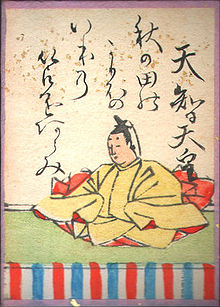- Competitive karuta
-
"Competitive Karuta" Kyogi Karuta (競技かるた) is one of the card game played with “Ogura Hyakunin Isshu” poetry. There are other ways of playing Karuta[1] which is less demanding and easy to play therefore more popular among general public.
See also: Uta-garutaMany games are played officially and privately during new year celebration.
Contents
overview
Competitive Karuta had been played through 19th centuries with various rules. At the beginning of 20th century, Karta Association was formed and rules were unified, then national competition had started.
Most of family in Japan have a set of Karuta as well as a deck of card. Although Karuta is very popular in Japan, there are not many players of competitive Karuta. It is estimated that there are about 10000 to 20000 players in Japan, of which 2000 are above C-class (above 1 Dan) and registered to the “All Japan Karta association”.
There are other associations of Karuta, one of them is “Nippon Karuta-in HonIn” which give more weight on cultural aspects of Karuta than competition.
Japan national championship tournament of competitive Karuta is held every January at Omi Jingu (Shinto Shrine) in Otsu city, Shiga and both winners of male and female division are given the title of Grand Champion (Meijin (male) Queen (female))
Karuta card
One set of Karta deck consists 200 cards of 100 poems of Tanka from 9th century or before.
- Yomi-Fuda (reading card); One hundred with a picture of a poet with a complete Tanka poem (5-7-5-7-7 syllables) a reciter keep these cards.
- Torifuda (playing card); another 100 with only lower (latter) phrases (7-7)
Rules
Competitive Karuta is a one on one game with a reciter (card reader) and a judge (usually one). Out of 100 Torifuda (lower phrase card) each player randomly pick 25 cards (face down), these 25 are player’s card and place them in front of each player face up. So total of 50 cards are in the match. Remaining 50 card are out of play (or ghost cards). First player clear all own cards is the winner. Basic rule is reader read upper phrases of one of 100 reading cards, and player takes lower phrases card. When you take a card from opponent, you send one card to opponent.
Players are given 15 minutes to memorize cards before the match starts.
The match starts with the reciter reads the introduction poem which is not the part of the game. This introduction reading allows players to familiarize to the reciter’s voice and reading rhythm. From second reading game starts. The reciter reads one card from 100 including 50 ghost cards which are out of play.
Fault (False touch)
- When a live (in the play) card was read and touched the wrong card of same side (either your side or opponent’s side) of correct card, is not penalized.
- However touching a wrong card at opposite side of correct card is penalized and receive one card from opponent.
Double fault
- When you picked a right card from opponent side, and opponent touched a card of your side. Opponent is penalized by receiving two of your cards.
- When player touched any card when ghost card was read. Penalty is receiving two cards from opponent.
The layout of your cards can be rearranged during the match by notifying opponent, however frequent or rearrange involving many cards are not welcomed.
Characteristic of game
Beside memorizing all 100 Tanka-poems, player must memorize layout of cards at the match which changes as game progress.
There are 86 poems with unique first 3 syllables, so player must react as soon as hearing beginning part of the poem, therefore good reflection is required to take a card as well as physical speed. One match last about 90 minutes including 15 minutes pre-match memorizing time. In the national tournament 5 to 7 matches are played by a winner.
Mental as well as physical endurance are tested in the tournament. It is reported that tournament player may loose up to 4kg (8.8lb) during the process.[2]
Because of the tension, tactic and fast dynamic movements, it is described as “fight club” as physical sports. [3]
Official games
- Individual match
there are 5 levels of individual tournaments by ranking group (Dan=grade).
- A class; 4-Dan or above
- B class; 2, 3-Dan
- C class; 1-Dan
- D class without Dan
- E class beginner
There are about 50 official tournaments every year which are counted for ranking of Dan.
- Group match
Media coverage
Beside news coverages of official tournaments, there are several drama, Manga and Animation staged in Kyogi Karuta. i.e. Chihayafuru
References
- ^ The word Karuta loaned from the Portuguese “carta”
- ^ Waseda University “Don’t grab those karutacards, let them fly!” accessed 2011-11-17
- ^ Asahi Newspaper “Rising popularity of Kyogi Karuta” accessed 2011-11-17
See also
- Ogura Hyakunin Isshu
- Uta-garuta
external link
- YouTube clip explain the rule "Hyakunin Isshu Karuta game"
- another good clip but in Japanese Kyogi Karuta 1
Categories:- Wikipedia articles needing cleanup after translation
Wikimedia Foundation. 2010.


